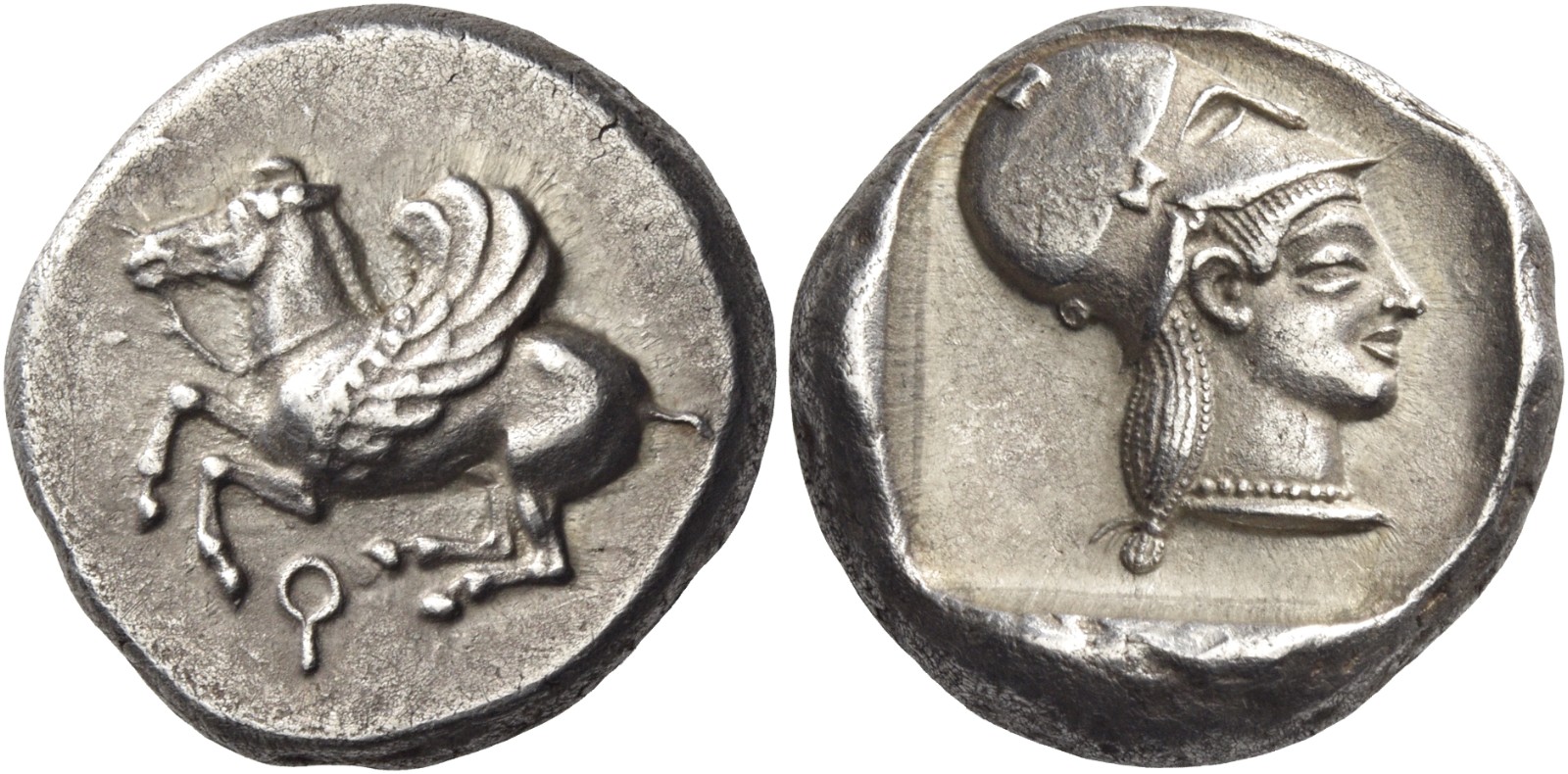1755 - Metapontum (nomos ear of barley/ear of barley) over Corinthian type (Pegasus/Athena) (Oxford, AM)
From SILVER
540 BCE - 510 BCEMETA
Images
Overstruck variety

SO 1210 - Metapontum over Corinth overstruck variety.jpg [1]
Location/history
| Museum collectionMuseum collection: | Oxford, Ashmolean Museum | |
Overstriking coin
Description
| ObverseInscription or printing placed on the obverse.: | META (Greek) Ear of barley with five grains. Decorated border. | ReverseInscription or printing placed on the reverse.: | Incuse ear of barley with [six] grains. Border of rays (incuse). |
Mint and issuing power
| MintIdentifies the place of manufacture or issue of a numismatic object.: | Metapontum | Ancient regionAncient region. | Lucania | Modern countryModern country: Italy | AuthorityIdentifies the issuing power. The authority can be "pretended" when the name or the portrait of X is on the coin but he/she was not the issuing power. It can also be "uncertain" when there is no mention of X on the coin but he/she was the issuing power according to the historical sources: |
Chronology
| FromIdentifies the initial date in a range assigned in a numismatic context. 540 BCE toIdentifies the final date in a range assigned in a numismatic context.. 510 BCE | Archaic until 480 BC |
Physical description
| MetalThe physical material (usually metal) from which an object is made.: Silver |
WeightWeight of the numismatic object (in grams). in grams: 7.577.57 g <br />7,570 mg <br /> | DenominationTerm indicating the value of a numismatic object. Examples: tetradrachm, chalkous, denarius.: nomos | |
| StandardStandard.: Achaian | |||
References
| Coin referenceReference of the Coin: | Sutherland 1952, p. 115-116. | Coin series referenceReference to coin series study: | HN Italy1HN Italy, n° 1459, 1463, 1465, 1467, 1470, 1472, 1474, 1479, 1481-1486, HGC 12HGC 1, n° 1027-1029 |
| Coin series web referenceCoin series web references: | |||
Overstruck type
Description
| ObverseInscription or printing placed on the obverse.: | Pegasus right (visible on reverse of the coin). | ReverseInscription or printing placed on the reverse.: | Head of Athena right, wearing Corinthian helmet, within incuse square (visible on obverse of the coin: outlines of the incuse square, top and face-piece of the helmet, the base of the hair-queue, the neck-truncation and chin). |
Mint and issuing power
| MintIdentifies the place of manufacture or issue of a numismatic object. ᵖ: | Corinth | Ancient regionAncient region. ᵖ | Peloponnesus | Modern countryModern country: Greece | AuthorityIdentifies the authority in whose name (explicitly or implicitly) a numismatic object was issued. ᵖ: |
Chronology
| FromIdentifies the initial date in a range assigned in a numismatic context. 500 BCE toIdentifies the final date in a range assigned in a numismatic context.. 450 BCE | Archaic until 480 BC |
Physical description
| DenominationTerm indicating the value of a numismatic object. Examples: tetradrachm, chalkous, denarius. ᵖ: | stater |
StandardStandard. ᵖ: | Aeginetic |
References
| Coin type referenceReference to coin series study ᵖ: | Ravel 19363Ravel 1936, 2nd period, 1st class (T 94-T 130), HGC 44HGC 4, n° 1823 | ||
| Coin series web reference overstruckCoin series web references overstruck: | |||
Additional data
| Frequency of overstrikesFrequency of overstrikes: | frequent | Level of confidenceLevel of confidence of the identification: | sure |
| RemarksRemarks: | |||
References
- ^ Rutter N. Keith et alii (eds.) (2001), Historia Numorum Italy, London, xvi, 223 p., 43 pl.
- ^ Hoover, Oliver D. (2018), The Handbook of Greek Coinage Series, Volume 1. Handbook of Coins of Italy and Magna Graecia, Sixth to First Centuries BC., Lancaster-London, 2018, lxi, 527 pages, 23 cm
- ^ Ravel, Oscar E (1936), Les "Poulains" de Corinthe : monographie des statères corinthiens. Tome I: de 650 à 415 J.-C., Basel.
- ^ Hoover, Oliver D. (2014), Handbook of Greek Coinage Series 4. Northern and Central Greece : Achaia Phthiotis, Ainis, Magnesia, Malis, Oita, Perrhaibia, Thessaly, Akarnania, Aitolia, Lokris, Phokis, Boiotia, Euboia, Attica, Megaris and Corinthia, sixth to first centuries BC, Lancaster, lxxi, 563 p.
